2002 Prinsendam (II) Part II
This is the history of the ms Prinsendam. In a different format than the other ships on the blog site. I was privileged to be invited to come on board for the final voyage of the ship. A 14 day North Cape cruise, with the request to perform a lecture about the he history of the ship. I decided to turn that into two performances bringing the background of the why the Prinsendam (as Royal Viking Sun) came into the equation as well. Below are the slides and the narration of those two lectures.
Note:
Some of the interior photos of the RVS were googled on the internet. Making it nearly impossible to trace who the original maker is. If the original maker happens to come across this blog, please place a comment and I will gladly credit the right person who documented the early days.

The origins of the name Prinsendam goes back to the mid 30’s. In the depth of the depression the company was planning a new ship, for better times, and the first name that was considered was Prinsendam. In he beginning the decision was to go for Nieuw Amsterdam named after the original name of New York. In 1973 it was decided to give the name to the first purpose built cruise ship of Holland America. Then in 2002 the name was used again for “The Elegant Explorer”, a smaller company ship meant to focus on the more unusual routes.

There is a lot of confusion about the origins of the name Prinsendam as there is no town or region or river in the Netherlands with that name. In the 1930’s the naming system of the company centered around town or location names. A challenge they had was that there was a ship named after the capital of the Netherlands, a ship named after the home of the company Rotterdam, but nothing after the 3rd city of the Netherlands The Hague, which is where the Monarch of the Country lives and where the houses of Parliament are situated.
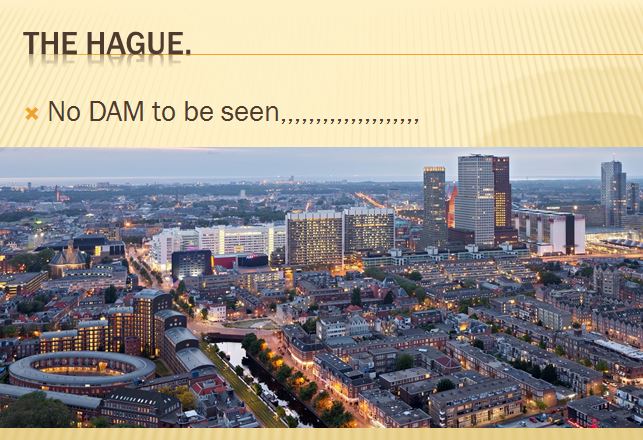
There is no “Dam” in the name of The Hague and also no major dam in sight that could be used. But the City has been the capital of the Netherlands since the grey mists of time and has the nickname the “Princenhof” = where the Prince (Prins in Dutch) lived. And the Prince was the head of state before the Netherlands became a kingdom. And that gave enough possibilities to rework the name into Prins + Dam = Prinsendam.

The Prinsendam was originally built as the Royal Viking Sun and thus our story starts with that company. By the late sixties the airplane had made Passenger Liners on regular services obsolete. Many of the old Ocean Liners disappeared and a few made a more or less transition to the full time cruise ship business. Holland America Line was one such company. But most of the other established Passenger ship company’s found it very hard to make the change although they recognized the potential.
 Thus newcomers saw a chance. Not hindered by historical ballast or being set in their ways, they approached their objectives in a very simple way. What is our market, what does the market want and what sort of ships do we have to build to achieve that. It resulted in the start up of a large number of new company’s. Some of those are still out there and are now the largest Cruise ship company’s in the world.
Thus newcomers saw a chance. Not hindered by historical ballast or being set in their ways, they approached their objectives in a very simple way. What is our market, what does the market want and what sort of ships do we have to build to achieve that. It resulted in the start up of a large number of new company’s. Some of those are still out there and are now the largest Cruise ship company’s in the world.
Carnival Cruise Lines, Norwegian Cruise Lines, Royal Carribbean Cruise Line, Princess Cruises just to name a few.
These were predominantly for the mass market, but the cruise industry is defined in three main groups, Mass market, Premium Market and Luxury Market. A group of rich Norwegian Shipping Owners also saw a future in the Luxury market. The principle was not so difficult, look at Holland America and then bump the service up to a six star standard and build ships who can deliver that. The concept for the Royal Viking Line was born.

The three shipowners, each financed a ship and the new company was coordinated by Mr. Warren Titus who had interested these shipowners for the idea in the first place. He had also been involved in starting up Princess Cruises and pushing for ferry cruises to Alaska. He opened a main office in San Francisco as it was quite clear that the clientele, the rich clientele, had to come from the American Market.

All three ships were built by Wartsila in Helsinki. The Royal Viking Sun which came much later would come from Turku but also in Finland. With 21,500 tons they were average size ships for the time of day but they carried only 550 guests which was less than comparable ships which would have around 800 guests. An important part of the service on board was that dining took place in one sitting and that meant that a large part of one public deck was completely given over to the dining room.

Although the concept of Royal Viking was very sound, the revenue part of the equation was not that good. The ship size to guest ratio was simply too big, more guests should be on board to make and keep it financially viable so that a profit could be made each year. Around 1980 a new CEO appeared, Mr. Torstein Hagen (Now the founder of the new Viking Line) and he decided to stretch the three ships by 93 feet so that the capacity could increase by 200 guests, which with similar costing would improve the profit margin. The ships were sent one by to A.G Weser in Bremerhaven between 1981 and 1983. Gross Tonnage rose and also cabins – penthouses – were added, something that was new for those days.
The shipowners were still not completely happy and decided to sell the whole company to Norwegian Cruise Line in 1984. Owner of this conglomerate was Mr. Knut Kloster who thought that a luxury company next to his mass market company of NCL was a good idea. He also realized that a mass market company did not necessarily know what was needed for the Six star luxury market. so he turned to those who should know; the guests themselves and the crew who served them. Concept Viking Excelsior was introduced to create the ultimate luxury cruise ship in the world.

A large number of ideas were brought forward. Lido with overhang against the rain; no soot on deck, and observation lounge and plenty of forward viewing when going through scenic locations. If you look at this artist concept you can see quite a few ideas which later were used for other cruise ship developments. Not all idea’s were accepted; there was a large group of guests who conducted a real crusade against the idea of having a Casino on board; but the casino came, albeit a small one. Two ships were planned, The Royal Viking Sun and the Royal Viking Nova.
The idea was to maintain the basic concept of the older Royal Viking Ships but add a number of public rooms to offer more options for the guests. Same as her Predecessors the Royal Viking Sun was constructed in Finland under yard number 1298.
Basic plan was: increase the size by a 3rd. up to 38000 tons but keep the keep the guest count the same as the previous smaller ships. I do not think it was not a coincidence that this size was almost the same as that of the ss Rotterdam of Holland America Line, a ship which ran a very successful world cruise program.
On 26 January 1987 the order was placed and the total cost was going to be in the area of US 125 ml. Approx. 15 ml., 10% dearer, than a comparable mass market cruise ship of the same size would have cost. 15 months later the ship was floated out and delivered on 26 November 1988.

As was becoming common in those days, the ship was not built on a slipway but in a building dock. This gave the advantage that the ship could be built in sections or modules and did not have to be built up layer by layer or deck by deck. Secondary, as there was no weight limit, something that always had to be considered when using a slipway (so the hull would still slide into the water) interior furnishings such as bathroom modules etc. could already be put in place. When the work had commenced far enough that the dry- building-dock was not longer needed, the hull was floated out and towed to the fitting out pier.
 This slide shows how section building in a building dock took place. The hull was not even completely assembled and major parts of the engine room were already lifted in. Also for the top of the ship large steel sections where lifted into place as complete and then welded together.
This slide shows how section building in a building dock took place. The hull was not even completely assembled and major parts of the engine room were already lifted in. Also for the top of the ship large steel sections where lifted into place as complete and then welded together.

A date not many people know is that the Royal Viking Sun was floated out on 11 June. Search the internet and it will give May or something else very vague. But 11 June was the date given to me by the original builders of the ship when they came and visit the Prinsendam in 2018. The Prinsendam was in Turku during her cruise and on instigation of the Chief Engineer Mr. Massolt all the (now retired) shipbuilders who still could be traced came for lunch. This was quite emotional as the Royal Viking Sun was the first major cruise ship that was built in Turku and for them a way forward to a bright future. They still remembered how they built the ship and were very interested in the subsequent changes made to the ship over the years.

Once at the fitting out pier the ship was finished. The module shown two slides ago is now easily recognizable as the horizontal wide band above the pool under construction.
So what was so special about the ship ? First of all the design was a combination of factors. Experience with the previous ships amenities that could be offered but also what the RV guests were looking for. Although not always profitable the company had built up a very loyal clientele who were all consulted and did come forward with all sorts of idea’s and also complaints. They made a lot of noise when Royal Viking decided to incorporate a Casino in the ship. Maybe a bit of snobbishness but the large majority were not very happy that they had to hear the ding ding of the fruit machines going.
An improvement over the previous ships was the addition of larger public rooms for the same number of guests which increased the space ratio up to 48, which at that time was by far the highest in the cruise industry. Still they were somewhat hampered in the ships design as RV had a one seating dining room system which meant that all 750+ guests had to have a space at the same time. This meant that the dining room took over nearly 2/3 of one deck. To provide kitchen capacity for the high level of service and food options, the galley was split up in two parts. One part next to the Dining room and the other part for the – pre prep of the food, a few decks down.

The Stella Polaris Lounge, a large Crowsnest seen here being fitted out. There were balconies for the suites and the very large outside cabins, a Night Club, not a Disco, but a Night Club, a concept that Knut Kloster brought over from the Norway project; and on request of the guests, swimming pools that were long enough to really swim in. RV solved that by having one long and fairly narrow pool and two small side pools were you could swim against a jet stream. Following Scandinavian taste the overall decor was very light with a lot of metal, an image she kept until Holland America took her on.

This is the pool area behind the Fittness Spa, the center tank for the pool and the jet stream swim tank to the left can be easily recognized.

The aft staircase going down from deck 11 to deck 5 resembled more a staircase in a early 20th century apartment building than that of a modern cruise ship. As explained to me by one of the original yard workers, the designer wanted rounded lines in the staircase and not just square steps. A n inspiration which was repeated for the forward staircase.

Still unfinished the starboard side of Deck 8 the walkway from the dining room along the movie theater towards the Shore Excursion Office.
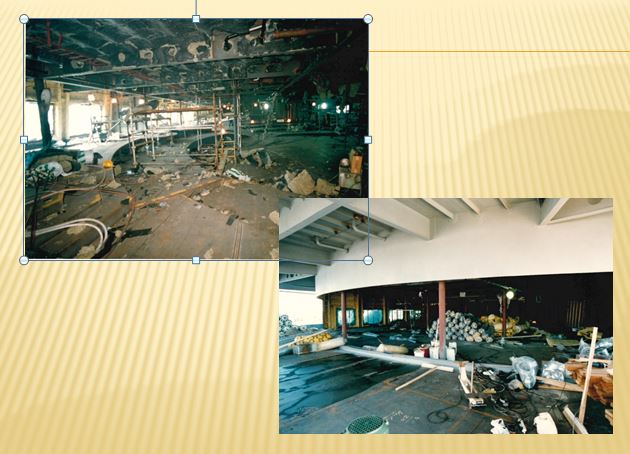
The Dining room under construction both inside and outside. This is the aft part overlooking the open deck towards the stern.

An area harder to recognize for the the current Prinsendam guest, the Midnight Sun Lounge, as it does not exist anymore. When Holland America took over and went to a two sitting dining concept, all show elements were concentrated into the show lounge and this space was used for installing extra cabins. Later the area was extended with even more cabins in 2010.

When the Royal Viking Sun was completed she sported a white hull with a blue band and flew the Nassau flag as was standard for Royal Viking Lines. Although the company claimed to be very Norwegian their allegiance did not go that far that they were also willing to be support Norway with the tax system.
Particulars:
TONN. BRT: 37,485 NRT: 14,045 DWT: 6,150
BUILT AT: Oy Wartsila Marine Industries Abo, Turku, Finland.
BUILT IN: 1988 YARDNO: 1298
ENGINES: Four 8 cylinder ZAL40S Wartsila Sulzer diesel engines.
ENGINE OUTPUT: 28,552 BHP/21,120 KW PROPS: Two (Pitch)
SERVICE SPD: 20.5 Knots. MAX. SPEED: 21.8 Knots.
LENGTH.O.A: 204,00 Meters. LENGTH B.P.: 171,50 Meters.
BEAM OA: 28.90 Meters. DEPTH: 9,90 Meters.
DRAFT: 7,25 Meters. At 21,410 displacement in salt water
PAX.CAP: 768 (lower beds) in 380 cabins.
CREW: 469
SISTER SHIPS: None
NAME BACKGROUND: Company nomenclature starts with Royal Viking
REMARKS: Ice Bow. Two bow thrusters each 1300 HP. One retractable stern thruster 1300 HP (added during first dry dock)

Through the years the names of the decks and of the lounges and public amenities were changed when the ship moved from owner to owner. Thus the Owners suite, was also known as the Titus Warren suite, The Knorr Suite (named after an almost permanent occupier during the Seabourn days) and then the Penthouse by Holland America. The Suites were named after famous explorers and those names were never changed. The Sports area around the funnel would be re-invented several times with games coming and going according to the latest fashion or company insight.
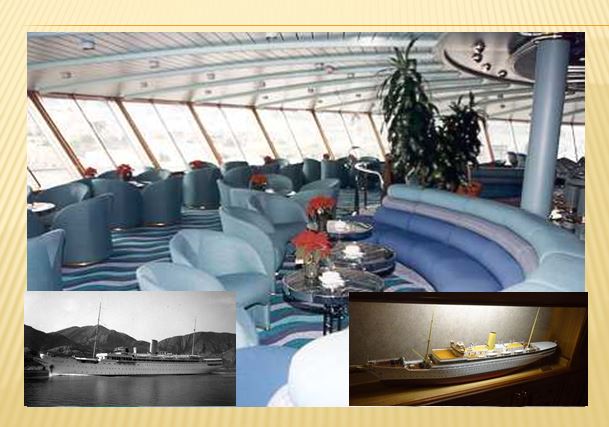
The name Stella Polaris came from an early Norwegian Cruise ship the yacht like Stella Polaris which was often the preferred choice of the more “posher” cruises to Scandinavia around the turn of the century. Hence the link to the “posh” Royal Viking Sun. A model of that ship was on display in the Lounge and is still on board as Holland America moved it to the Neptune Lounge which they created after the take over.
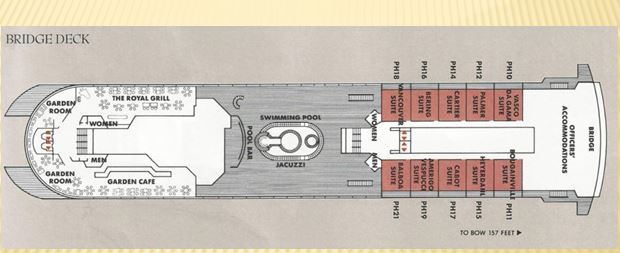
The Bridge Deck in later incarnations known as the Navigation Deck housed the bridge and staff cabins, the main pool area and then three public rooms around the funnel. These would later be combined into one self service restaurant.

Apart from the name above the outdoor bar this area has seen remarkably little change. It has been said that the partly open/ partly closed area was a compromise between the wishes of the crew (not to get wet during service) and the guests (wanting to be in the sun without the wind)

Royal Viking eschewed the idea of self service and although a secondary restaurant was appreciated it did have full service. This sort of marked the return of a specialty restaurant to the high seas, A specialty restaurant as such is nothing new to the high seas as the Hamburg America Line ships and later also the Cunarders had restaurants on board (The Ritz) for which you paid extra. The Royal Grill, see above, rolled over into the Garden Room and the Garden Cafe which would later be changed into a Self Service Restaurant by Seabourn and then upgraded by Holland America Line.

The least changed area through the years was Deck 9 (deck 10 is cabins only so that has not changed at all) where only one public area was located the Spa. This area was updated during the Seabourn and HAL years but location remained the same.

The original lay out of the Spa area. Book stands on the treadmills and paintings on the ceiling do not suffice anymore.

An issue which the ship (and those walking under it) was the fact that with a pitching ship, the water started to build up into an ever higher wave. If that wave became high enough it was splash over the pool rim and down onto deck 8. Which was also the walk around deck of the ship and could result in an wet surprise for a passerby. It was not until Holland America extended the deck that the issue was solved.

As can be expected deck 8 which was the main entertainment deck saw the most changes through the years. In RVS days it had the Norway lounge ( main show lounge) near the bow and the Midnight Sun lounge (night club) near the stern. The Oak room on the port side served as a cigar retreat and the Royal Arcade separated the shop from the Starlight Cinema. Starboard side had the Compass Rose Room which according to witnesses took the overflow of the Card room as this room could not handle the number of Bridge Players on average on board.

There was a small library compared to the big card room. Tastes change through the years and when the ship came to Holland America, the locations were switched and thus there was now a small card room and a large library.

The Midnight Sun Lounge which did not look much different to the main show lounge but was smaller. A main feature was the Glass Elevator casing which made it possible to descend in full view into the lounge.

Deck 7 had the wrap around Promenade deck and housed the Main Dining room. Because Royal Viking had one seating, the dining room took up most of the deck space. For operational reasons the dining room wrapped itself around the serving part of the galley. Most food was prepared, or pre-prepared in another large galley on Deck 4.
The forward staircase ran as an open staircase from deck 4 to deck 8. This Atrium is split in two parts deck 4 to deck 6 and deck 6 to deck 8. Deck 6 to 8 is the focus point of the ship and I assume they were not able to make the glass sculpture there two decks longer. Still splitting the Atrium in two sections has the advantage that the cold air from the gangway or tender entrance on deck 4 does not go all the way to the top. With the Royal Viking Sun there was only a female bow head figure hanging from the deck rim of deck 7 and A viking longboat on a pedestal, made by Nicolaas Wallenberg. Holland America added the Glass sculpture in 2002.
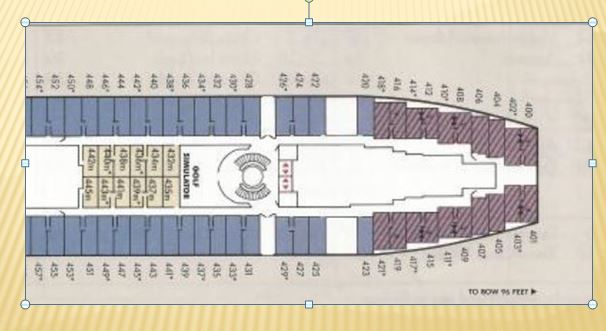
A bit out of the way on deck 5 or Pacific Deck was a public room dedicated to a Gulf Simulator. A Golf Pro was available to help guests to improve their swing before they headed out in the various ports to go golfing.

While the Royal Viking Sun was constructed the company sent out letters to their worldwide agents with the request for a gift which would connect to their port of country and which could go on display in the ship. This resulted in many nice objects forwarded to the ship and these were displayed in the staircases and corridors of the ship. (Especially in the long corridor towards the Stella Polaris Lounge)

A more peculiar item on board was the Open Fire in the Oak Room. This was a throwback to the old Ocean Liner days when the ships had indeed open fires on board. The black and white photo to the right is from a Union Castle Mail liner to South Africa in the early days of the past century. I do not know how the company managed to get an open fire past the authorities, but when the ship arrived on American Shores it quickly came to an end. If you open a little door to the right of the right bookcase you can still see the operating buttons of the fire suppression system. This photo is from the Prinsendam days as I never managed to get a photo with the Norwegian King above the fire place which was there in Royal Viking days.

The ship was not baptized at the shipyard but sailed with guests on board via England and the Panama Canal to San Francisco. Here she as christened on 8 January 1989. Going against convention the ship did not have a God Mother, but a God father, the actor James Stewart. From San Francisco she commenced on a 100 day inaugural world cruise. Then she sailed everywhere in the world, battling it out in the six star segment with the Germans, who introduced two ships, The Deutschland and the Europa in the same market segment. This saw Royal Viking losing some of its German clientele but compensating that with a larger exposure to the American Market. The ship was successful in it’s service, managing the ship and the rest of the fleet financially was a little bit more of a challenge.

Through the years, the company made a good profit some years but a loss in the other years. For the mother company Kloster Cruise this was a constant headache. The other part Norwegian Cruise Lines which also operated the ss Norway was bringing in good returns but Royal Viking was somehow lagging behind. Mr. Kloster who was the operating owner found that the amount of time management needed to spend on the luxury part of the company was in no relation to the return on the investment and decided to look for another owner. Before that happened it was decided to add a small vessel to the fleet. This was the 3rd new building which was meant for another -new start up- company, called Seabourn. She joined Royal Viking as the Royal Viking Queen but was also a 3rd of the size of her older sister. This combination did not work out that well and hence the search for a new owner became more urgent.

That new owner became the Cunard Line. On 30 June 1994 Kloster sold Royal Viking to Cunard. Cunard thought that it would be quite simple to integrate their new luxury acquisition in their existing fleet. This turned out to be more difficult than expected. First of all the company had ships in all sorts of seizes, varying from the large QE2 down to the small Seabourn vessels. A more diverse fleet is more difficult to find cost saving synergies but also it makes it more difficult to sell an identity to the travelling public and to keep the not so suitable idea’s from those other ships away from a prime product. Thus Cunard management had to deal with a very unbalanced fleet.
Then there was the bizarre ownership of the Cunard Line. First Trafalgar House and then Kvaerner. Both were industrial conglomerates with the emphasis on construction and other dry land activities. Bob the Builder might be good in building a house but is not necessarily good in running a cruise ship. Cunard decided to retain the Royal Viking Brand but to add the Cunard prefix to it, but to keep the ships name the same but was now marketed as Cunard Seabourn Sun with the Cunard funnel and the Fish Eagle logo of RVL on top of it.
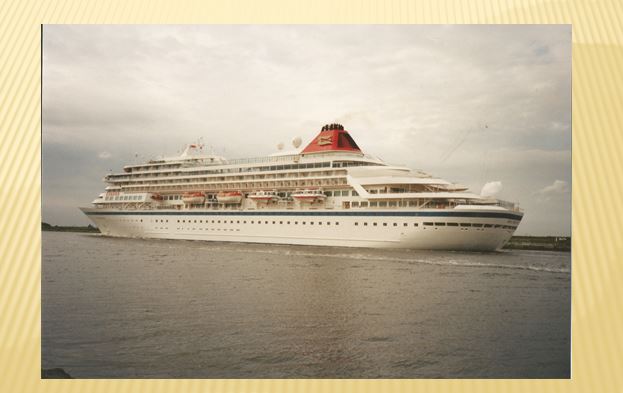
Then in Aug. 1998 Carnival Corporation took over Cunard /Seabourn and all relating to it. Cunard and Seabourn were split up and Seabourn became an independent Brand under the Carnival umbrella. The ship was renamed on 26 November 1999 to Seabourn Sun. She was brought under the Norwegian flag after a refurbishment at Lloyd Werft which lasted from 03 to 23 November 1999 and costed US 15. million. Major work was done on the Heath Spa, the Garden Café, the Midnight Sun lounge and all cabins received new fittings. The ship returning to service on 27 November 1999.
Still Seabourn did not operate as intended. A fleet that is comprised of a Mother Goose and three ducklings is hard to control and streamline. So Carnival Corp. kept reviewing the situation and then Holland America came into focus. The Holland America Line was the first company Carnival had acquired in 1989 in their quest to branch out into the Cruise business beyond the Mass Market.

See part II for the transfer of the Seabourn Sun to Holland America as their Prinsendam (II)
